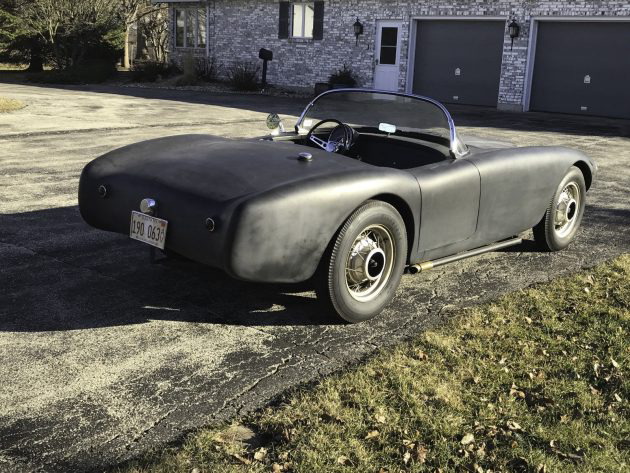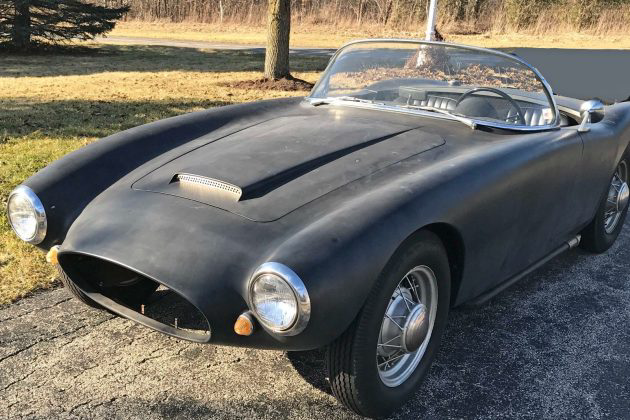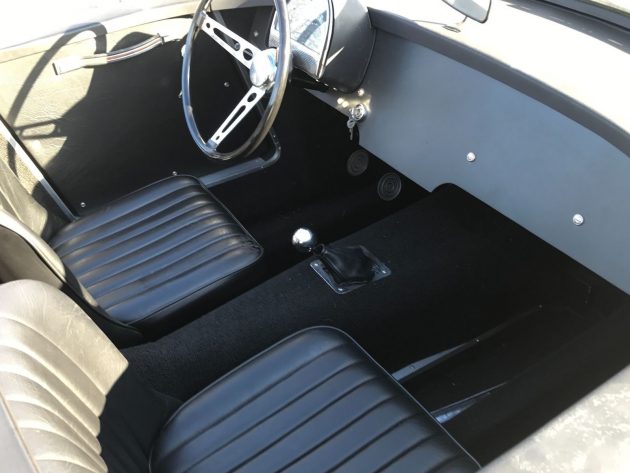Fiberglass Femme Fatale: 1957 Byers Special SR100
Being a car nut in Southern California in the 1950s must have been spectacular. In some strange quirk of fate, thousands of incredibly talented mechanics, engineers, drivers, and stylists all called this area home, and their contributions to the car culture were legendary. What resulted from the people and resources that gravitated here was nothing less than an automotive version of The Renaissance. One of the many new starts was the work of a talented designer by the name of Jim Byers, of El Segundo, California. An example of his stunning skill at designing a sports car is being auctioned on eBay, with bids passing $22,000 as of this writing.
There were a lot of fiberglass bodied “specials” being offered in the post war period, and a lot of them originated in Southern California. Fiberglass was a fairly new material to build cars from, and its ease of use made it ideal for making car bodies (in addition to making the people who used it itch like crazy). No longer hampered by the difficult and expensive process of making steel body parts, builders could construct a fiberglass mold and use various methods to make a semi-finished body that was rigid and held up well to stress. Of these many different fiberglass bodied specials, some were designed as whole sports cars from top to bottom, while others were designed to be sold as a kit to be placed on a common used car chassis. While information is scarce, my bet is that Mr. Byers ended up doing both with his beautiful design.
The seller references and displays an article from Road and Track’s February 1957 edition that describes in detail the Byers Special. Built for a doctor, the first version of the car made John Bond, the long time publisher of Road and Track, gush about its beauty. He was even deferential to the insanely complicated suspension that this first car sat on. Despite the fact that the front end sported a solid front axle to go with all the extra parts, Bond glossed over its shortcomings and all but ignored what producing the car would cost. Obviously, Bond saw real potential in the car mainly because of a stunning design that actually looks like it was influenced by the BMW 507.
While it is difficult to find any more information on the car beyond the Road and Track article, clues on this particular car lead me to believe that Byers later sold body kits for an existing chassis. While there are no pictures of the frame available, I doubt he had the funds to build complete cars or even his own chassis. My guess is that the chassis used on this car was that of a pre-war Ford. Builders loved using these no doubt due to the long production runs with the same parts that Ford preferred, and for the Flathead Ford V-8, which was the engine of choice for hot rodders of that time. As seen in the picture above, our first clue is the Flathead Ford mill resting under the hood, complete with speed parts from the period.
Our next clue is the beam axle and leaf spring seen through the grill opening in the front of the car. While I may be mistaken, I think these are 40-48 components. Our final clue is the wire wheels seen in the first three pictures. These are 1935 Ford wire wheels, which will fit to 1940-48 Ford drums with a simple adaptor plate.
Of course, there is not a thing in the world wrong with he way this car is built. Putting the car that John Bond tested into full production would have been a financial and logistical nightmare. Using existing components that are common and inexpensive allowed Mr. Byers to realize his dream of producing his own car. Compared to a lot of others, he hit it out of the park. The styling of the car being sold here is sensational, and I’d bet it moves down the road just fine. You could do a lot worse with your money than buying a car like this. It is a rolling history lesson from a magical land where dreams had four wheels, and the dreamers had the guts to turn those dreams into reality.
Auctions Ending Soon
 2002 Subaru Impreza WRXBid Now2 days$333
2002 Subaru Impreza WRXBid Now2 days$333
 1975 Chevrolet Corvette ConvertibleBid Now2 days$4,000
1975 Chevrolet Corvette ConvertibleBid Now2 days$4,000
 1964 Ford F-100 Camper CustomBid Now2 days$2,000
1964 Ford F-100 Camper CustomBid Now2 days$2,000
 2006 Jeep Wrangler SportBid Now4 days$10,500
2006 Jeep Wrangler SportBid Now4 days$10,500
 1974 Datsun 260ZBid Now6 days$750
1974 Datsun 260ZBid Now6 days$750







Comments
WoW !
what a combo (that body’n the flattie underpinnings)
That’s about all I could come up with after reading the write up and just plain admiring the car. Wow. Where is this mindset nowadays? Out there but too scarce, and dare I say, commercial…
probably rides and handles like a lumber wagon, but with a nice paint job that would be one beautiful lumber wagon. I love it!
What a beautiful design. It likely does drive like an antique; but I bet the flathead sounds great.
One of the favorite donor cars for a Byers was the MGA. I have seen one vintage raced in California – it was an MGA chassis with a Volvo B18 engine
( The Volvo swap was quite popular for MG TD’s, TFs, and MGAs, because
one got a very strong reliable engine making in excess of 100 hp with virtually the same weight as the less powerful MG engines.)
http://bringatrailer.com/2017/07/03/period-built-w-lots-of-potential-1957-byers-sr-100-ford-flathead-special/
It would sell today like crazy!
Thought you would enjoy the read from ForgottenFiberglass.com:
http://www.forgottenfiberglass.com/fiberglass-car-marques/byers/hard-work-determination-dave-peterson-resurrects-history-snedeker-byers-sr100/
and 25 other references to Byers there.
Forgotten Fiberglass has been bombarding me with content after months of inaction. The spirit of the back yard builder is strong in that one.
The same cottage industry turning out all those Cobra replicas should be making these. That car is flat out gorgeous!
I agree! Absolutely gorgeous lines.
Getting the rights to resume production is probably the main obstacle. The original molds might be available, otherwise you need to make new ones. Without a car to take molds from, you are in for lots of steps.
Absolutely correct John D. Lots of steps before the finished product.
Back in the early 70’s we went through the whole process of producing fibreglass bucks and bodies which we then fitted to donor VW Beetle chassis. It was called a “Zeus” and came complete with roll up windows. We ended up making only 21 as the production costs were too much to cover.
Great write up connecting the dots Jeff
No surprise or quirk of fate that all those clever folks ended up in SoCal. WWII brought many people to the West Coast either to be transported to the action, or to work in all of the defense plants up and down the coast. My father-in-law was one of those guys. He was born on a farm in Page, North Dakota and got the heck out of there as soon as he was old enough to join the navy. He settled in the Bay Area post-war and worked in electronics in what became Silicon Valley.
@ John D
Moulding is a lot easier these days with CAD and 3D printing. A friend has recently produced full-sized body bucks for prestige 50s sports racing and F1 cars by scanning 1/18 scale models. These bucks are works of art in themselves.
I don´t see much BMW 507 in the Bailey, more Italian barchetta such as Siata.
Sounds like your friend is the one we should be buying new bodies from. There are still rights in the patent/copyrights issues to overcome.
I think I saw this car compared to a Cobra, earlier this year. Was it a Forgotten Fiberglass post?
My first impression was that it was where the Cobra seed was planted.
That is remarkably nice. So many of the fiberglass home built cars were incredibly ugly.
The rear fins could have been done a little sleeker but that front end is as gorgeous as it could be. Seems to me that with the right suspension as well as motor and trans. you could have a beautiful modern day classic. Oh, to be a young man today!
These are neat cars. I have one that was originaly built in the late 50s. I found it in an old warehouse. Now it’s my toy.
My dad was a Marine Corps pilot based around Long Beach CA between WWII and Korea. He put this fiberglass (Glasspar?) body on a 35 Ford chassis and had a Mercury engine in it. It had aircraft seats and parachute harness seatbelts. After moving back to Virginia and NC, it really turned heads since not many had seen these things.
Just looked up the AC Ace for “frame of reference”, and those began in ’53 & this sure looks similar enough to that and various Italian sports cars of that vintage to be different, but not super original. Likewise, whomever compared it to the BMW 500 series gets “kudos”. To me it appears the windscreen is from a ’53 or ’54 Corvette…so that gives me an indication of it’s size. Funny (to me) is that I lived in SoCal in 1960 and another Jim Byers and his son Jim, Jr. were family friends…just not the guys that had anything to do with this car. Small world.
I see this and see ac ace and bmw 500- …but the byers is a bit wider i think